AMD Ryzen 9 5980HS Cezanne Review: Ryzen 5000 Mobile Tested
by Dr. Ian Cutress on January 26, 2021 9:00 AM EST- Posted in
- CPUs
- AMD
- Vega
- Ryzen
- Zen 3
- Renoir
- Notebook
- Ryzen 9 5980HS
- Ryzen 5000 Mobile
- Cezanne
CPU Tests: Simulation
Simulation and Science have a lot of overlap in the benchmarking world, however for this distinction we’re separating into two segments mostly based on the utility of the resulting data. The benchmarks that fall under Science have a distinct use for the data they output – in our Simulation section, these act more like synthetics but at some level are still trying to simulate a given environment.
DigiCortex v1.35: link
DigiCortex is a pet project for the visualization of neuron and synapse activity in the brain. The software comes with a variety of benchmark modes, and we take the small benchmark which runs a 32k neuron/1.8B synapse simulation, similar to a small slug.
The results on the output are given as a fraction of whether the system can simulate in real-time, so anything above a value of one is suitable for real-time work. The benchmark offers a 'no firing synapse' mode, which in essence detects DRAM and bus speed, however we take the firing mode which adds CPU work with every firing.
The software originally shipped with a benchmark that recorded the first few cycles and output a result. So while fast multi-threaded processors this made the benchmark last less than a few seconds, slow dual-core processors could be running for almost an hour. There is also the issue of DigiCortex starting with a base neuron/synapse map in ‘off mode’, giving a high result in the first few cycles as none of the nodes are currently active. We found that the performance settles down into a steady state after a while (when the model is actively in use), so we asked the author to allow for a ‘warm-up’ phase and for the benchmark to be the average over a second sample time.
For our test, we give the benchmark 20000 cycles to warm up and then take the data over the next 10000 cycles seconds for the test – on a modern processor this takes 30 seconds and 150 seconds respectively. This is then repeated a minimum of 10 times, with the first three results rejected. Results are shown as a multiple of real-time calculation.
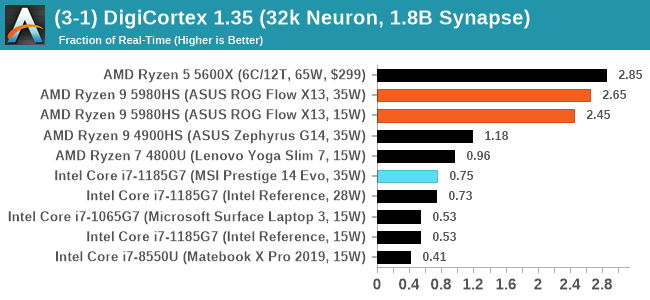
DigiCortex seems to have taken a shine to Zen 3, especially processors with a single chiplet of cores. Intel can't seem to compete here.
Dwarf Fortress 0.44.12: Link
Another long standing request for our benchmark suite has been Dwarf Fortress, a popular management/roguelike indie video game, first launched in 2006 and still being regularly updated today, aiming for a Steam launch sometime in the future.
Emulating the ASCII interfaces of old, this title is a rather complex beast, which can generate environments subject to millennia of rule, famous faces, peasants, and key historical figures and events. The further you get into the game, depending on the size of the world, the slower it becomes as it has to simulate more famous people, more world events, and the natural way that humanoid creatures take over an environment. Like some kind of virus.
For our test we’re using DFMark. DFMark is a benchmark built by vorsgren on the Bay12Forums that gives two different modes built on DFHack: world generation and embark. These tests can be configured, but range anywhere from 3 minutes to several hours. After analyzing the test, we ended up going for three different world generation sizes:
- Small, a 65x65 world with 250 years, 10 civilizations and 4 megabeasts
- Medium, a 127x127 world with 550 years, 10 civilizations and 4 megabeasts
- Large, a 257x257 world with 550 years, 40 civilizations and 10 megabeasts
DFMark outputs the time to run any given test, so this is what we use for the output. We loop the small test for as many times possible in 10 minutes, the medium test for as many times in 30 minutes, and the large test for as many times in an hour.
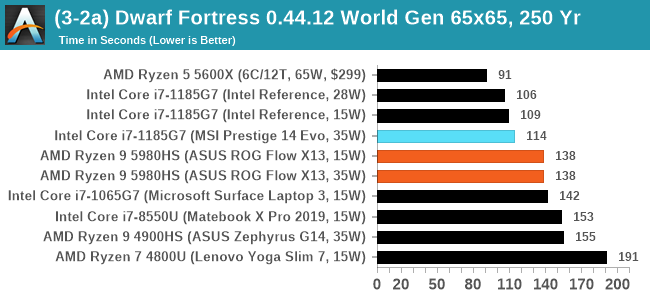
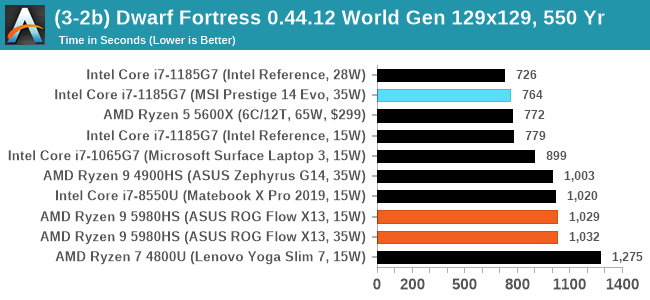
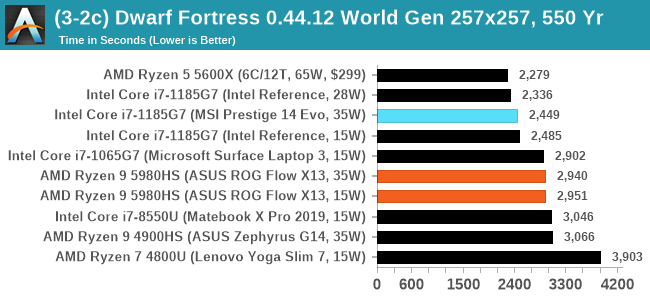
DF has historically been an Intel favorite, and we're not seeing much of a speedup for mobile Zen 3 over mobile Zen 2 here.
Dolphin v5.0 Emulation: Link
Many emulators are often bound by single thread CPU performance, and general reports tended to suggest that Haswell provided a significant boost to emulator performance. This benchmark runs a Wii program that ray traces a complex 3D scene inside the Dolphin Wii emulator. Performance on this benchmark is a good proxy of the speed of Dolphin CPU emulation, which is an intensive single core task using most aspects of a CPU. Results are given in seconds, where the Wii itself scores 1051 seconds.
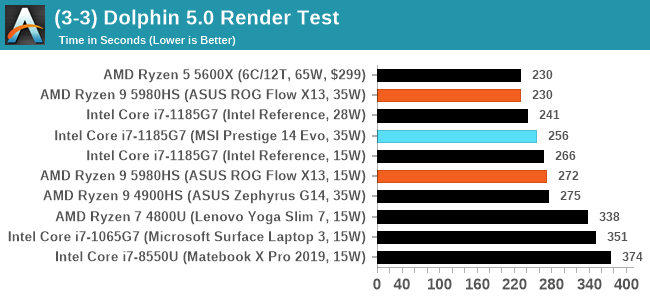
The 35W variant of Cezanne pushes through here, matching the desktop processor, and a sizeable performance jump over the previous generation Renoir.












218 Comments
View All Comments
Smell This - Tuesday, January 26, 2021 - link
LOL @ ZoZo ___ he is messin' with you, ts
You are correct in that Dr Su and AMD has played yet another "Rope-A-Dope" on the competition. I suspect RDNA2/Navi II will raise its pretty head after the "Lexa" cores run their course. It has been a productive run.
There are Radeon pro CNDA1 cores floating around that will likely evolve into the RX 6500 RDNA2/Navi IIs discreet replacements for Lexa. These will be the Display Core Next: 3.0 // Video Core Next: 3.0 arch associated with the Big Navi.
And ... I don't think AMD is being lazy. I think the Zen2/Zen3 APU product stack is being developed as yet to be revealed. Home / Office / Creator ? There is a Radeon Pro Mac Navi Mobile with RDNA1 discreet video w/HBM2.
We will see how the 6xxx APUs evolve. Grab your popcorn!
TelstarTOS - Tuesday, January 26, 2021 - link
lazy, definitely lazy.vortmax2 - Saturday, January 30, 2021 - link
One sees lazy, another sees smart business decision.samal90 - Friday, February 12, 2021 - link
The APU in 2022 will use RDNA 2 finally. Expect a substantial GPU performance lift next year with the new Rembrandt chip.Spunjji - Thursday, January 28, 2021 - link
A console APU is not a PC APU - they have completely different design constraints and memory architectures. Vega was used here because it allowed AMD to bring Zen 3 APUs to market faster than they managed with Zen 2 - it's all mentioned in the review that you're commenting on......sandeep_r_89 - Friday, January 29, 2021 - link
The consoles don't use iGPUs.......most likely, RDNA2 design so far hasn't been designed for low power usage, it's focused more on high performance. Once they do the work to create a low power version, it can appear in iGPUs, laptop dGPUs, low end desktop dGPUs etc.Netmsm - Tuesday, January 26, 2021 - link
any hope for Intel?Deicidium369 - Wednesday, January 27, 2021 - link
LOL. Any hope for AMD?Releases Zen 3, RDNA2 and consoles - and only grows revenue $240M over Q3.... Didn't even gross $10B last year.
Meanwhile Intel posts 5 YEARS of record growth...
Spunjji - Thursday, January 28, 2021 - link
A discussion of a company's technological competitiveness is not a discussion of their financial health. Any dolt knows this, why do you pretend we can't see you moving the goalposts in *every single comment section*?Spunjji - Thursday, January 28, 2021 - link
This post is even more hilarious in the context of AMD's financial disclosure today 😁